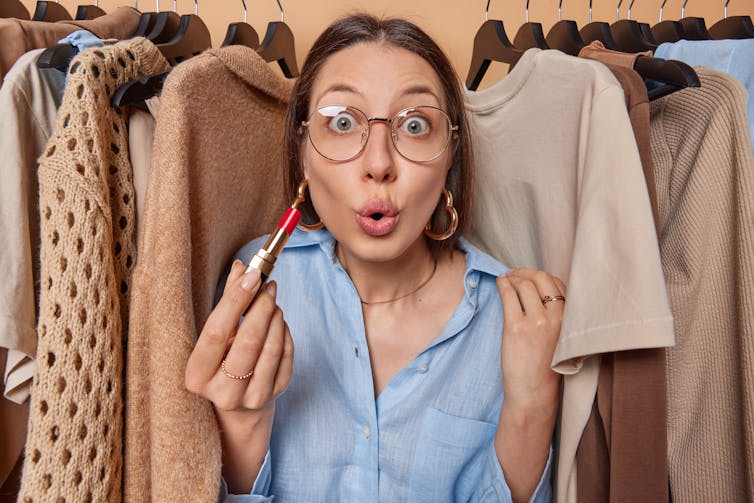Kokho Jason Sit, University of Portsmouth
Life today is stressful. Since the start of the pandemic, social media has been flooded with coping mechanisms and wellbeing trends to help people manage their emotions and worries about the state of the world. If you’ve tried therapy and “hot girl walks”, you may also have heard of the latest life hack: buying yourself a little treat.
Inflation and high cost of living is putting holidays and luxury goods out of reach. In their place, indulgences like coffees, ice cream, lipstick or face masks can deliver pleasure in small doses. Treats are not expensive, nor are they a huge commitment. The ideal treat might be from a shop within walking distance of your home or office. You might even think of an episode of “guilty pleasure” television as a treat – a mid-afternoon Emily in Paris break, for example.
“Treat culture” is not an entirely new concept. You may have heard it called the “lipstick index”, the theory that consumers buy low-cost luxuries to boost their moods in difficult times. There is a wealth of research on “compensatory consumption”, where people spend money to deal with perceived threats to their self-esteem, confidence or happiness. Treat culture is “retail therapy”, but with a focus on small, inexpensive purchases rather than a shopping spree.

This article is part of Quarter Life, a series about issues affecting those of us in our twenties and thirties. From the challenges of beginning a career and taking care of our mental health, to the excitement of starting a family, adopting a pet or just making friends as an adult. The articles in this series explore the questions and bring answers as we navigate this turbulent period of life.
You may be interested in:
Cost of living crisis: what are your rights if your landlord wants to increase your rent?
Five ways to be a good ‘housemate’ to your parents
Expert advice for budding UK entrepreneurs during a cost of living crisis
In recent research, I examined how consumers use shopping to cope with difficult times. During the pandemic, when people were restricted from dining out, they would instead buy higher-quality items at the grocery store. Eating better at home, even if the cost was higher than the usual shop, was a treat for people.
And in recent years, the popularity of novelty businesses like
the Danish variety store Flying Tiger and bubble tea shops has grown. These businesses are perfect for people to partake in treat culture.
The experience of treats
Treat culture isn’t just about the treat itself, it’s about the emotional experience – that is, how you feel about purchasing and having the treat. As one report pointed out, the phrasing of buying yourself a “little” treat reflects an element of cuteness.
Cuteness can prompt powerful emotions of happiness, and remind us of nurturing and protective qualities. In a way, partaking in treat culture is a way to nurture ourselves. There is also a connection between cuteness and consumption, for example in Japanese culture, where the popularity of kawaii (cute) products is driven by a consumer desire to cope with stress and reconnect with their childhood self.
Emotions are a key part of great consumer experiences. Research shows that experiential purchases, like meals out or concert tickets, deliver greater satisfaction and happiness to consumers than products.
Similarly, the positive emotions that come from buying a treat are not derived from the iced coffee or face mask itself. They stem from the consumption experience – taking a break from work, feeling you have earned the reward of a treat, and that you are doing something to care for your emotions.

WAYHOME studio/Shutterstock
Treat responsibly
Treat culture could easily be seen as a negative indulgence. It suggests frivolous spending, a lack of self-control and ignorance of financial risks like debt. Some commentators have argued that treat culture preys on young consumers’ insecurities, for example, about their skin, perpetuating a cycle of needing to buy more skincare products in search of easy “fixes” for imperfections.
But treat culture, I believe, is a low-risk way to experience a morsel of happiness in dark times. The cost is usually minuscule (a bubble tea costs around £5), and you probably won’t be tempted to use a buy-now-pay-later scheme to finance it. To fully experience the satisfaction of treat culture, you should be able to purchase and consume the product in person, for optimal instant gratification. So, spending debt is unlikely and post-purchase remorse is unnecessary.
Treat culture certainly has psychological benefits, helping uplift consumers’ emotions during difficult times. So, go ahead – buy yourself a little treat.![]()
Kokho Jason Sit, Senior lecturer in Marketing; Associate Head (Global), University of Portsmouth
This article is republished from The Conversation under a Creative Commons license. Read the original article.

